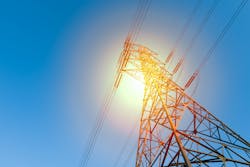California ISO Board Approves 26 Transmission Projects Adding Capacity Of 85 GW By 2035
The Independent System Operator’s (ISO) Board of Governors has approved the ISO’s 2023-2024 transmission plan recommending 26 new projects to support the addition of 85 GW of capacity by 2035, including the first phase of development expected to bring offshore wind energy from the North Coast to the California grid.
The Board has also approved Pattern Energy’s application to tie its 550-mile SunZia line into the California system. The line, which is currently under construction, will run between central New Mexico and south-central Arizona, with capacity to transport 3,000 MW of wind energy to California and neighboring states.
The SunZia development is the second transmission line approved by the Board using an innovative Subscriber Participating Transmission Owner (SPTO) model, which helps new transmission lines outside the ISO balancing area to connect generation to the California grid and provide the ISO operational control.
Entities subscribing to use the line help finance its upfront costs without increasing the ISO’s transmission access charge. Individual load-serving entities across the West will have the opportunity to sign long-term contracts to purchase renewable energy delivered by the new infrastructure.
The 2023-2024 Transmission Plan, developed with the California Energy Commission, the California Public Utilities Commission and the energy industry, has an estimated cost at full buildout of $6.1 billion and recommends specific transmission upgrades based on reliability, policy and economic-driven concerns.
Two of the projects recommended in the plan have been identified as eligible for competitive solicitation. The plan will enable critical resource development, including:
· Over 38 GW of solar generation distributed across the state in solar development regions that include the Westlands area in the Central Valley, Tehachapi, the Kramer area in San Bernardino County, Riverside County, and also in southern Nevada and western Arizona;
· Over 3 GW of in-state wind generation in existing wind development regions, including Tehachapi;
· Over 21 GW of geothermal development, primarily in the Imperial Valley and in southern Nevada;
· Access for battery storage projects co-located across the state with renewable generation projects, as well as stand-alone storage located closer to major load centers in the LA Basin, greater Bay Area, and San Diego;
· The import of over 5.6 GW of out-of-state wind generation from Idaho, Wyoming and New Mexico, by enhancing corridors from the ISO border in southeastern Nevada and from western Arizona into California load centers; and
· Over 4.7 GW of offshore wind with 3.1 GW in the Central Coast and 1.6 GW in the North Coast area.
Specific projects recommended in the plan to integrate offshore wind from the North Coast, include:
· A new Humboldt 500kV substation complete with a 500/115kV transformer;
· A new HVDC line (approximately 260 miles), initially operated as a 500kV AC line to interconnect the new Humboldt 500 kV substation to the Collinsville 500kV substation;
· A new 500kV AC line (approximately 140 miles) to interconnect new Humboldt 500kV substation to the Fern Road 500kV substation;
· A 115kV line from the new Humboldt 500kV line to existing Humboldt 115kV substation, and a 115kV phase-shifting transformer at the Humboldt 115 kV substation; and
· A host of smaller upgrades improving supply of load and access to other smaller resource zones.
The ISO will work with regulators and industry for the timing and sequencing of offshore wind development to ensure reliability and affordability for electricity consumers.
After additional stakeholder comments on an addendum to the Interconnection Process Enhancements Track 2 final proposal are considered, a vote is scheduled for a Board meeting on June 12.
The Board and Western Energy Imbalance Market Governing Body also approved an important stakeholder driven initiative to make it feasible for resources with limited capacity such as battery storage and hydro power to bid above a soft offer cap of $1,000 per MWh required under the Federal Energy Regulatory Commission’s Order Number 831 in 2016.
The initiative is required as bids for those resources are driven by opportunity costs associated with future prices. The ISO will have a mechanism to verify costs from these resources above $1,000, required by the FERC order.
